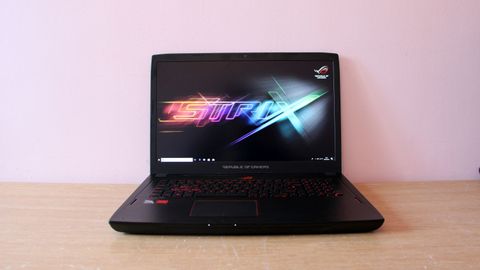Why you can trust TechRadar
Here's how the Asus ROG Strix GL702ZC performed in our suite of benchmark tests:
3DMark: Sky Diver: 25219 ; Fire Strike: 9035; Time Spy: 3613
Cinebench CPU: 1307 points; Graphics: 91.21fps
GeekBench: 3340 (single-core); 15578 (multi-core)
PCMark 8 (Home Test): 3795 points
PCMark 8 Battery Life: 1hr 3mins
Battery Life (techradar movie test): 1hr 37mins
Middle Earth: Shadow of War: 103fps; (1080p, Low): 45fps (1080p, Ultra)
Total War: Warhammer II: 129fps; (1080p, Low); 49fps (1080p, Ultra)
Installing a desktop CPU in a laptop is an unusual move, and Asus has relied on first-generation Ryzen for this machine – but cramming AMD silicon inside the GL702ZC makes plenty of sense.
The eight cores can address sixteen concurrent tasks, which means that the Asus has enough multi-tasking ability to handle content creation, video work and creative applications.
The chip runs at a solid 3GHz that reaches 3.7GHz with Turbo, and it’s paired with 16GB of memory, a 256GB SSD and a 2TB hard disk.
The octo-core CPU delivered Geekbench single- and multi-threaded results of 3,340 and 15,578. They’re great results: the former is on par with anything Intel can offer in consumer laptops at this price, while the latter is around 3,000 points beyond Intel’s current six- and quad-core laptop processors. The GL702ZC’s Cinebench score of 1,307cb was twice as good as its rivals from HP and Asus, too.

Those excellent results mean the Asus will handle photo-editing tools, video-editing software and content creation applications with more pace than any rival. Unsurprisingly, web browsing, office applications and games won’t prove problematic either.
Graphical grunt comes from an AMD Radeon RX 580 – another bit of desktop silicon. The GPU has 2,304 stream processors and 4GB of memory, but its 1,257MHz core has been clocked down to 1,077MHz in order to help improve this laptop’s thermal prospects.
It may not have the specification to match the GTX 1070 GPUs included in its rivals, but it’s still a potent part. It zipped through our test games at Ultra settings at more than 40fps, and it scored an impressive 25,219 in the 3D Mark Sky Diver test – only a few hundred points behind the HP Omen and Asus machines.
The GTX 1070 will be a little quicker in games, and its extra memory will give it more headroom for future titles.
Don’t fret, though: any current game will run smoothly on the AMD-powered Asus, and it easily has enough power for graphical work. It’ll also output to larger screens without issue.
The one disappointing result came in the storage test, where the SSD delivered read and write speeds of 441MB/s and 405MB/s. They’re poor, even for a SATA drive. You’ll notice the difference in loading times. And, annoyingly, the Asus uses single-channel memory – another odd inclusion that will impact performance.
The powerful, desktop-level internals work well for gaming and content creation, but they do hinder the Asus in thermal tests. The processor and graphics card peaked at 70°C and 80°C during a gaming test, which is fine, but the CPU topped out at 94°C in a full-system test. That’s too high, and a worry if you want to use this laptop for work. The Asus was consistently louder than its rivals, too.
Battery life isn’t anything to shout about, either. The Asus could only deliver around an hour of longevity in gaming and tough work tests, so you won’t get much more than that even with careful power management. You certainly won’t’ get a full day away from the mains.
Screen and Speakers
The Asus’ 17.3in screen is a 1080p IPS panel with 60Hz AMD FreeSync. So, if you run games at 60fps or below, the GPU and screen refresh rates will be synchronised for butter-smooth gaming.
That’s great, but the HP has a 4K panel, and both rivals also have syncing technology.
The GL702ZC delivered inconsistent quality, too. Its 391cd/m2 brightness level and 0.34cd/m2 black measurement are both good, and the contrast ratio of 1,150:1 is solid – high enough to provide impressive depth in games and films.
The average Delta E of 8.4 is disappointing, though, and the color temperature of 7,688K is too cool. The panel also only rendered 83.7% of the sRGB colour gamut.
Those latter results saw games and films look a little pallid, and they also mean that the Asus’ panel doesn’t have the colour accuracy required for many creative tasks. If pixel-perfect colours are key for you, the GL702ZC won’t be good enough.
The speakers, meanwhile, have loads of volume and bass, and good punch elsewhere. The treble range is a little muddy, but the audio kit is good enough for gaming and entertainment.
Verdict
The Asus offers loads of power, especially in the processor department, and it serves up a desktop-level GPU inside an attractive and ergonomically-pleasing enclosure.
In other departments it’s far more ordinary, though – which leaves this laptop feeling a little unbalanced, even if the price is tempting.
AMD’s desktop processor and graphics card deliver great performance, especially in multi-threaded applications – but the GL702ZC’s sheer grunt comes at a price. This laptop is louder and larger than most of its competition, and it brings disappointing battery life along for the ride.
However, it is also ergonomically solid and has plenty of power, but unless you need eight cores then you’d be better off with a more balanced machine that relies on traditional notebook components.
- Check out our pick of the best laptops of 2018
Mike has worked as a technology journalist for more than a decade and has written for most of the UK’s big technology titles alongside numerous global outlets. He loves PCs, laptops and any new hardware, and covers everything from the latest business trends to high-end gaming gear.

